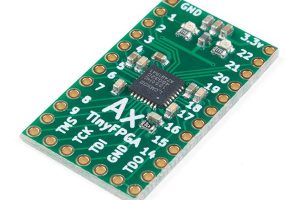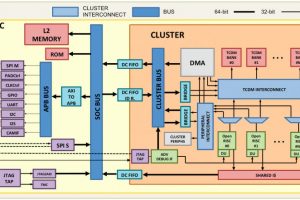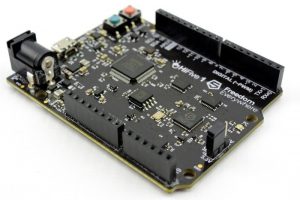And let’s assume they were going to have ARM Cortex-M_ cores in them.
Now that ARM is no longer independent, I can see two futures:
Softbank keeps ARM independent, and CortexM_ continues to be the core inside things.
Softbank tweaks ARM in some wrong direction, potential licencees get nervous, and they scout around for something else.
So, what is that something else?
Well, MIPS has some great small cores and Imagination (owners of MIPS) has a solid reputation for licencing IP through what it has done with its PowerVR graphics cores.
It doesn’t have the giant ecosystem the ARM architecture has, but it does have Microchip making MIPS microcontrollers* (PIC32s) and Longsoon from China makes chips with MIPS64 cores. * This said, Microchip has just bought Atmel, with its long list of ARM-based chips.
Then there some cores that are available under a nominally free licence: RISC-V and OpenRISC, for example.
And, if the world’s most powerful computer can emerge apparently by magic from China, with a totally new architecture, what else might spring from that vast country?
Cost is going to be such an important factor if billions of IoT nodes are going to be made, that maybe any cheap core that doesn’t use too much memory and can run a wireless stack (so probably 32bit) will do – and arriving with free stacks would be an advantage, as would an effective C-compiler.
Security is one big thing with IoT – if nodes are not secure (except perhaps in the most trivial applications) they will get hacked, and that would sometimes open a route into the rest of the networks they are part of including attached phones.
ARM appears to be very advanced in both IoT hardware and software security, and anyone wanting to make up ground on it is going to have to work very hard – MIPS is also working on security.
I am looking forward to seeing how it all pans out.
BTW: ‘Architecture’
I am breaking my own rules today – the above use of ‘architecture’ is shorthand for ‘instruction set architecture’ (ISA) which describes the instructions that are executed. I should really have said ‘instruction set’ throughout – that is protected intellectual property for most processors.
The A in ISA is really a marketing theft of the word architecture, which was far better used describing how the processor hardware works – as in von Neumanm and Harvard architectures. As it happens, various hardware architectures are used to execute, for example, the ARM instruction set amongst the Cortex A_, R_ and M_ cores.
 Electronics Weekly Electronics Design & Components Tech News
Electronics Weekly Electronics Design & Components Tech News




Interesting article!
Since this article is looking for an alternative for the Cortex M core MCU targeting the embedded field, we should not forget that there are companies out there, who are actually designing proprietary suitable cores for this embedded application field.
Yes, not all of those cores are 32bit architectures, like the Microchip PIC. But there is one 32bit architectures which is from performance point of view far ahead from the Cortex M core and tuned for the embedded application field, too. This is the 32bit RX family of Renesas, who tend to be the largest MCU manufacture. I believe that could be a suitable candidate!
Hi BeWillus
I don’t think Renesas licenses the core for other people’s silicon – or am I wrong here?
Thanks for all the wisdom folks.
I was thinking 32bit because the core has to run an RF comms stack, IP stack and having a good chance to do the crypto-processing, and I am not sure 8bit processors are going to cut the mustard for all of this (though TCP/IP looks covered), but am happy to be corrected.
As far as I know, Microchip uses MIPS and now ARM (after buying Atmel – and therefore also AVR32 up its sleeve), and both TI and Cypress promote ARM cores for IoT applications – but again I am happy to be corrected.
Thanks for the tip on Cortus – and the Andes advert! (which I am going to edit a little).
ARC I should have included. But thinking about it, I am not sure that is thought of as completely independent any more – and, does it come in a compact version (sort of Cortex-M0 equivalent) as MIPS clearly does?
If you can run a full TCP/IP stack on 6502 (source code is published) I would have thought that 8 and 16 bit processors also would be relevant and likely use a whole less power.
Andes is an interesting company, seems they were in stealth mode for rather a long time. Unfortunately not much is published about the details.
Thanks SEPAM
I bow to your TCP/IP knowledge,
What you said reminded mo of Jennic – the Sheffield radio+MPU firm that got bought by NXP – some of that stuff would seem ideal for IoT use.
I also await Andes details.
I am not sure I understand the comment “I am not sure that is thought of as completely independent anymore”. ARC processors and subsystems, like any other IP in Synopsys’ DesignWare portfolio, can be licensed by anyone who needs a processor for their application.
As far as the comment on a compact version: The ARC EM family of processors provides a range of configurable and extensible options.
Hi Rich
My comment meant:
While ARM has been its own company until now, ARC ceased to be an independent company 7 years ago, and I believe the ARC IP now belongs to Synopsys?
I am guessing you work for Synopsys, as you to have added a little advert to the end of your comment, which I am going to edit a little like I did the Andes comment – I hope that is OK.
IoT applications are typically small, like sensors with specialised functions. For such purposes one can also use 6502, an architecture that after 40 years could be considered bug free. indeed pace makers are amongst the uses, taking the meaning “life time guarantee” to a new level. WDC sells IP for about 200 million units, annually. With an 8 bit architecture the chip area will be tiny.
For software there is for instance Contiki that provides OS with TCP/IP and more.
Synopsys ARC processors – Under talked architecture for IoT – very low area and low power.
Surprisingly the article seems to overlook Synopsys’ ARC processors, the 2nd most pervasive processor IP. Especially for IoT, Synopsys is the only global IP supplier that can meet the stringent power and area goals for IoT edge nodes with processors and other IoT-optimized IP. ARC was also the first to introduce security for IoT devices on its ultra-low power EM cores.
Please note that there is another CPU architecture ideally tailored for IoT applications from Taiwan-based Andes Technology.
In June, Andes announced the Quick-Start Design Package for SoC designs.
The N650 CPU provides the performance-efficiency needed for entry-level SoC, and the Platform IP offers several peripherals and the bus fabric.
Instead of hardwired control logic, customers can use software created with AndeSight IDE to debug the SOC and control the various peripherals.
There is already a big number of proprietary architectures in use by semiconductor companies e.g. Microchip, TI and Cypress to name a few. There is no reason to think they will be abandoned soon.
As we can see in the above advertizement above Andes would like to play. Another company is Cortus which I think is a relatively new but active. Then there is the big question mark, RISC V? Supported by many heavyweigthers like Google, HP, IBM, Oracle, Nvidia and Qualcomm. They could be a tremendous gamechanger, but it remains to be seen. What we need to think about is that a move towards RISC V is a long term effort not happen overnight. Not to forget ARC Tensilica and dark horses
Softmachines and Rex Computing.
So, if not ARM, make your picks there is a bunch to select among